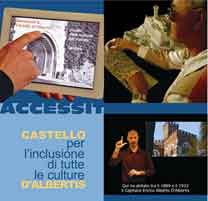Castello D'Albertis - Museum of World Cultures
This unique house-museum offers an extraordinary opportunity to immerse oneself in the world of its creator, the Captain Enrico Alberto D’Albertis, who generously gifted it to the City of Genoa upon his death in 1932. Through his adventures across land and sea between the 19th and the 20th centuries, the Captain gathered stories and artefacts and brought them back to be housed in this romantic frame inspired by ‘curiosity cabinets’ and the colonial trophies commonly collected at the time. As documented by numerous construction drawings, the castle itself, built in the neo-gothic style, encapsulates the Captain’s deep love for the sea, his curiosity for the unknown and the unexplored, his fascination for the unfamiliar worlds he visited and, underneath it all, his deeply Genoese soul.
The museum’s collections, presented in a sequence of evocative alcoves furnished according to the “revival” style of the time, are composed of ethnographic and archaeological materials gathered by the Captain across five continents; to these are added those collected by the Captain’s cousin Luigi Maria, the first to explore the Fly river in New Guinea (1872-1878).
Entering the 16th-century bastion on which the castle stands, visitors can follow a route that takes them through further extra-European collections acquired by the city in the last century, including archaeological materials from Central and South America and ethnographic materials from Canada donated by the US Catholic Mission Association following the exposition for the Columbian celebrations of 1892. All these materials, displayed with a thoughtful, contemporary exhibition design, have been revisited and contextualised through a dialogue with their source communities.
Top Ten
The Captain gathered extensive testimonies and materials from populations all over the world to form ethnographic and archaeological, nautical and photographic collections that join his extensive assortment of sundials.
The presence of neo-gothic design elements, rich with the influence of the Hispano-Moorish and “oriental” styles popular at the time, finds its pinnacle where hundreds of pieces (furnishings, pendants, arms, vases, couches, hookahs, lamps, and ostrich eggs, to name a few) peep out from under the curtained ceiling, all to create the effect of being in an “exotic” tent.
The Oceanic materials gathered by the Captain in Australia, Melanesia, and the Polynesian islands are joined by the important Mesoamerican (Aztec, Teotihuacan, Costa Rica) archaeological collections and by pieces from the Hopi tribe of Arizona. African weaponry from Sudan and Zambia, Chinese lances, and European halberds have been replaced in their original position, where they decorate the stairway joining the ground floor to the first floor.
Among the materials donated to the city during the Columbian celebrations of 1892, the artefacts from indigenous peoples of the Plains (US and Canada), clay and textile grave goods from pre-Hispanic South American civilisations, and Mayan fragments in volcanic tuff from the acropolis of Copán in Honduras are of particular anthropological importance.
The museum is also home to the Captain’s library and all its volumes, which include Ethiopian manuscripts in the Ge’ez language and works on Ceylon paper made from palm leaves.












Follow us on Facebook
Follow us on Tripadvisor